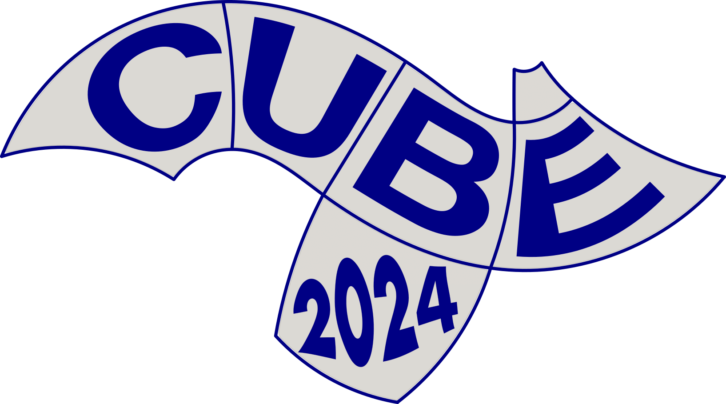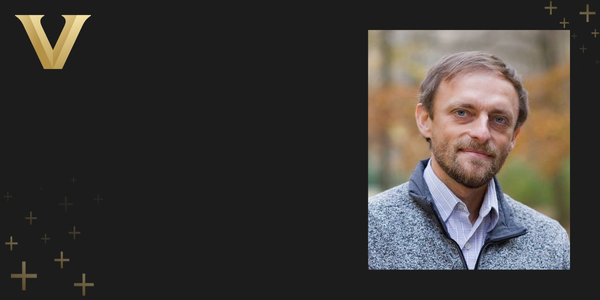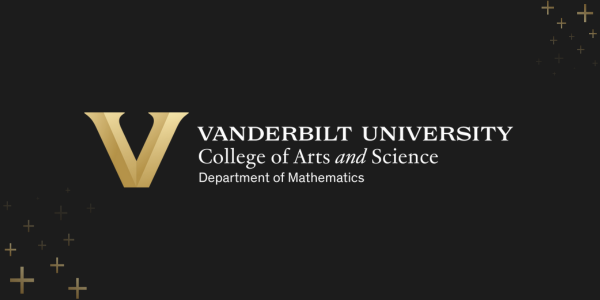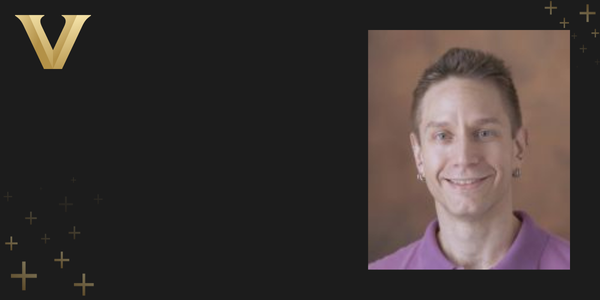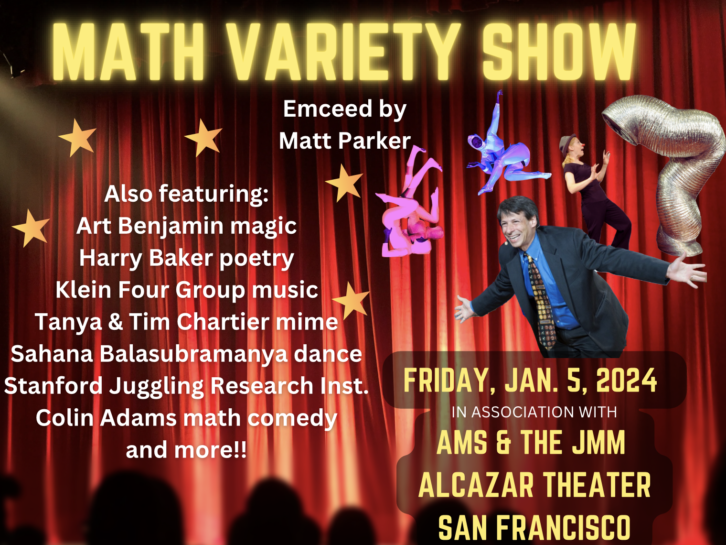Author
2024 CUBE program announced
Mar. 29, 2024—The 2024 CUBE Program is an in-person summer research experience for undergraduates. This year’s program will be held on the beautiful campus of Vanderbilt University in Nashville, TN. Participants will conduct research in groups of 2-3 under the supervision of research faculty, postdoctoral scholars, and graduate students. The topics will be in the field of...
Denis Osin awarded Simons Fellowship
Mar. 27, 2024—Prof. Denis Osin has received a prestigious Simons Fellowship. According to the Simons Foundation web site: “The Simons Fellows program extends academic leaves from one term to a full year, enabling recipients to focus solely on research for the long periods often necessary for significant advances. The foundation is proud to support the work of...
Koichi Oyakawa receives Provost Pathbreaking Discovery Award
Mar. 9, 2024—Koichi Oyakawa, a PhD student in the Vanderbilt Mathematics Department, has received the Provost Pathbreaking Discovery Award. As stated in the citation, this premier award from the Provost and Vice Chancellor for Academic Affairs and the Vice Provost for Graduate Education and Dean of the Graduate School celebrates doctoral students who demonstrate truly exceptional research...
Dr. Lorenzo Gavassino wins the MERAC Prize
Mar. 6, 2024—Dr. Lorenzo Gavassino, a Postdoctoral Scholar in the Vanderbilt Department of Mathematics and member of the VandyGRAF Initiative, has been awarded the 2024 MERAC Prize in Theoretical Astrophysics for his PhD thesis. The prize is awarded by the European Astronomical Society. His thesis focused on a thermodynamics-based formulation of relativistic viscous hydrodynamics for multi-messenger and...
Prof. Osin publishes in Annals of Mathematics
Feb. 25, 2024—Prof. Denis Osin recently published a paper in Annals of Mathematics, widely considered the most prestigious journal in pure mathematics. The paper, “Wreath-like products of groups and their von Neumann algebras I: W*-superrigidity” was written with Adrian Ioana (UCSD), Ionut Chifan (U Iowa), and a former Vanderbilt Ph.D. student Bin Sun (Michigan State U). The...
Welcoming visiting Professor Cabrelli and Professor Molter
Feb. 6, 2024—The Department of Mathematics is pleased to host Carlos Cabrelli, Professor and Investigador Superior (the highest researcher rank in CONICET), along with Ursula Molter, Professor (and former Director of the IMAS UBA/CONICET the largest mathematics institute in Argentina). They are visiting the Department of Mathematics through the Vanderbilt Global Scholar Program. Professors Cabrelli and Molter...
Professor Laurent Baratchart to visit this spring
Feb. 6, 2024—Professor Laurent Baratchart, Research Director at INRIA Sophia Antipolis, France, is visiting the Department of Mathematics during the Spring semester of 2024. He is hosted by Professors Doug Hardin and Ed Saff. Professor Baratchart’s research areas include the analysis of harmonic fields, approximation, inverse potential problems, and control. He is teaching a graduate course on...
Rubik’s Cube Competition
Jan. 30, 2024—On Saturday, March 9, there will be a first-of-its-kind event on the Vanderbilt campus: a Rubik’s cube competition. This is the 50th anniversary year for the invention of this beloved puzzle. The competition will be held from 8 – 6 in the SLC ballroom. It will be facilitated by the World Cube Association and CubingUSA. ...
Prof. Ed Saff awarded Honorary Doctorate from National Schevchenko University of Kyiv, Ukraine
Dec. 30, 2023—Ed Saff, Distinguished Professor of Mathematics, has been granted the title of “Honorary Doctor of the Taras Shevchenko National University of Kyiv.” There will be an online ceremony on January 2, 2024, to celebrate the occasion, which coincides with Prof. Saff’s 80th birthday. Taras Shevchenko National University of Kyiv is the most prestigious university in...
Prof. Speck publishes research breakthrough on the big bang
Dec. 21, 2023—Prof. Jared Speck, along with Grigorios Fournodavlos (University of Crete) and Igor Rodnianski (Princeton University) recently published a breakthrough paper about the stability of the big bang theory. Their paper answers a 50-year-old conjecture made by physics. It was published in the highly-prestigious Journal of the American Mathematical Society, which is considered as one of...
Prof. Marcelo Disconzi publishes autobiographical children’s book
Dec. 13, 2023—Prof. Marcelo Disconzi published a children’s book in the “Who, Me?” series. Books in the series are designed to help young readers understand that scientists are regular people like themselves who are excited about learning and discovering new things and who decided to work hard in school in order to create scientific opportunities for themselves....
Prof. Anna Marie Bohmann receives Nordhaus Award
Dec. 7, 2023—Prof. Anna Marie Bohmann is the recipient of the 2023 Excellence in Undergraduate Teaching in the Natural Sciences award. This is a prestigious, college-wide award. Prof. Bohmann is known throughout Vanderbilt as a brilliant lecturer and an energetic advocate for her students. We are lucky to have her in our ranks! The award was presented...
Prof. Jared Speck to deliver AMS Invited Address
Nov. 30, 2023—Stevenson Chair Jared Speck will give one of three invited lectures at the Fall Southeastern Sectional Meeting of the American Mathematical Society, to be held at Florida State University, March 23-24, 2024. The title of his talk is Singularity Formation for the Equations of Einstein and Euler and the abstract is as follows: In recent...
Prof. Dan Margalit awarded 2024 Steele Prize for Mathematical Exposition
Nov. 28, 2023—The American Mathematical Society has awarded Benson Farb and Dan Margalit the 2024 Steele Prize for Mathematical Exposition. The award is in recognition of their book, A Primer on Mapping Class Groups, published by Princeton University Press in 2012. The Steele Prize for Mathematical Exposition is given annually for a book or substantial survey or...
Margalit awarded 2024 Steele Prize for Mathematical Exposition
Nov. 28, 2023—The American Mathematical Society has awarded Dan Margalit, Stevenson Chair in Mathematics, and Benson Farb (Univeristy of Chicago), the 2024 Steele Prize for Mathematical Exposition. The award is in recognition of their book, A Primer on Mapping Class Groups, published by Princeton University Press in 2012. The Steele Prize for Mathematical Exposition is given annually...
Prof. Costas Tsinakis Publishes New Book with Vanderbilt-Affiliated Colleagues
Nov. 11, 2023—Prof. Costas Tsinakis has published a new book entitled “Residuated Structures in Algebra and Logic” in the AMS book series Mathematical Surveys and Monographs. His two co-authors also have affiliations with Vanderbilt: George Metcalfe is a former Vanderbilt postdoc, while Francesco Paoli has visited Vanderbilt several times. The book is available from the American Mathematical...
Prof. Dietmar Bisch Awarded Major Interdisciplinary Grant
Nov. 9, 2023—Prof. Dietmar Bisch was awarded the three-grant W911NF-23-0026 from the US-Army Research Office. Entitled “Von Neumann Subfactors, Noncommutativity and Quantum Computing,” the $571,783.00 grant provides substantial support for graduate students and postdoctoral researchers. The research lies at the intersection of pure mathematics and quantum information theory.
Topical Collection on Population Dynamics in Honor of Glenn Webb
Oct. 31, 2023—Populations are ubiquitous in nature. All natural beings and natural phenomena can be viewed as populations. A central feature of all populations is their dynamic capacity – their ability to change. The understanding of population dynamics requires mathematical description, mathematical formulation, and mathematical analysis. These mathematical requirements have been central in the history of science....
Professor Margalit Delivers Mary Cartwright Accompanying Lecture
Oct. 23, 2023—Professor Dan Margalit was invited by the London Mathematical Society to deliver the 2023 Mary Cartwright Accompanying Lecture, which is organized by the Committee for Women and Diversity in Mathematics. More information is available here.
Shanks Conference on L-functions and Automorphic Forms
Oct. 9, 2023—On May 13-16, 2024, the Vanderbilt Department of Mathematics will host the Shanks International Conference on L-functions and Automorphic Forms. The conference will feature 24 speakers and covers topics on automorphic forms, L-functions, and the relation between the two. Kannan Soundararajan will be honored as the 36th Shanks Lecturer.
Osin awarded Simons Fellowship
Oct. 8, 2023—Professor of Mathematics Denis Osin received a prestigious Simons Fellowship. According to the Simons Foundation: “The Simons Fellows program extends academic leaves from one term to a full year, enabling recipients to focus solely on research for the long periods often necessary for significant advances. The foundation is proud to support the work of these...
Shanks Workshop on Combinatorics and Graph Theory
Oct. 7, 2023—On March 9-10, 2024, the Vanderbilt Department of Mathematics will host the Shanks Workshop on Combinatorics and Graph Theory. The workshop will bring together young researchers from different institutions and backgrounds to discuss recent developments on structural graph theory, extremal combinatorics, and graph colorings.
Chair of Mathematics, Dan Margalit co-organizing a variety show with Nancy Scherich
Oct. 4, 2023—Chair of Mathematics, Dan Margalit is co-organizing a variety show with Nancy Scherich, winner of the 2017 Dance Your Ph.D. competition. The show is called Mathematics: A Quick Revue, and it will be held on January 5, 2024 in conjunction with the 2024 Joint Mathematics Meetings. The performance will take place at the Alcazar Theater...
New Department Leadership
Aug. 23, 2023—Dan Margalit has joined the Vanderbilt faculty as Stevenson Professor and Chair of the Department of Mathematics. Margalit is a leading expert on low-dimensional topology and geometric group theory. A brief video introducing Professor Margalit and some other new A&S faculty is available here. The Vanderbilt article announcing Margalit’s arrival is available here.
Stevenson Chair Promotions
Aug. 11, 2023—Professors Akram Aldroubi and Jared Speck were appointed as Stevenson Chairs. Aldroubi is a leading expert in sampling theory, harmonic analysis, and their applications to signal and image processing. Speck is a leading expert on the mathematics of general relativity and shock waves.
